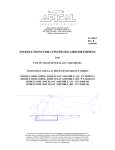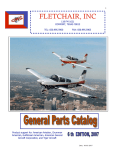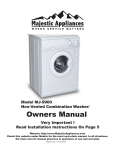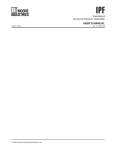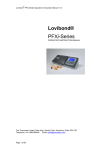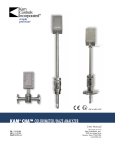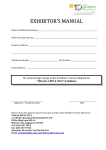Download ICA350-2 NC
Transcript
APICAL INDUSTRIES, INCORPORATED 2608 Temple Heights Drive Oceanside, California 92056 ICA350-2 Rev. N/C 97Oct02 INSTRUCTIONS FOR CONTINUED AIRWORTHINESS FOR UTILITY HELICOPTER FLOAT ASSEMBLIES EUROCOPTER HELICOPTER AS-350 FLOAT ASSEMBLY - P/N 20331-101 AND 20331-102 Page 1 APICAL INDUSTRIES, INCORPORATED 2608 Temple Heights Drive Oceanside, California 92056 ICA350-2 Rev. N/C 97Oct02 LOG OF ACCEPTED REVISIONS Apical Industries, Incorporated’s Instructions for Continued Airworthiness (ICA) for the Eurocopter AS-350 rotorcraft except for the Airworthiness Limitations Section (ALS) were reviewed by the Fort Worth Aircraft Evaluation Group (FTW AEG) and found to contain the applicable requirements specified in Appendix A to Federal Aviation Regulations Part 27, as appropriate, and do not contain any incorrect terminology or incorrect references. These ICA were found to contain a Cover Page, Log of Accepted Revisions, Revision Control Procedure and Record of Revisions, a List of Effective Pages, and a Table of Contents. No determination as to correct spelling, proper grammar, or accuracy of the information was made by the FTW AEG. For ICA having a required Airworthiness Limitations Section (ALS), the ICA will be acceptable when this page has been signed and dated by the FTW AEG and the ALS is approved by the Aircraft Certification Service. When the ICA do not require an approved ALS, the ICA will be acceptable when this page has been signed and dated by the FTW AEG. Revision Number Revision Date FAA Acceptance Signature N/C Page 2 Acceptance Date Accepting AEG Office APICAL INDUSTRIES, INCORPORATED 2608 Temple Heights Drive Oceanside, California 92056 ICA350-2 Rev. N/C 97Oct02 RECORD OF REVISIONS Revision Number N/C Issue Date Date Inserted By Revision Number Page 3 Issue Date Date Inserted By APICAL INDUSTRIES, INCORPORATED 2608 Temple Heights Drive Oceanside, California 92056 ICA350-2 Rev. N/C 97Oct02 DETAILS OF REVISIONS REV. DATE N/C 97Oct02 PAGE DESCRIPTION All Initial Release APPROVED Committee Page 4 APICAL INDUSTRIES, INCORPORATED 2608 Temple Heights Drive Oceanside, California 92056 ICA350-2 Rev. N/C 97Oct02 RECORD OF SERVICE BULLETINS (S/B’S) S/B NO. DATE DESCRIPTION Page 5 APICAL INDUSTRIES, INCORPORATED 2608 Temple Heights Drive Oceanside, California 92056 ICA350-2 Rev. N/C 97Oct02 LIST OF EFFECTIVE PAGES LIST OF REVISIONS Revision N/C 97Oct02 LIST OF EFFECTIVE PAGES Title Page Revision No. Cover Log of Accepted Revisions Record of Revisions Details of Revisions Record of Service Bulletins List of Effective Pages Table of Contents List of Tables and Figures Section 1.0 Introduction Section 4.0 Airworthiness Limitations Section 5.0 Inspection Requirements and Overhaul Schedule Section 9.0 Towing Section 11.0 Placards Section 25.0 Float Removal, Cleaning, Testing, Field Repairs and Reinstalling Attachment 1 Customer Feedback 1 2 3 4 5 6 7 Page 6 8 9-11 12 13 14 15 N/C N/C N/C N/C N/C N/C N/C N/C N/C N/C N/C N/C N/C 16-31 32 N/C N/C APICAL INDUSTRIES, INCORPORATED 2608 Temple Heights Drive Oceanside, California 92056 ICA350-2 Rev. N/C 97Oct02 TABLE OF CONTENTS Identification Title Section 1.0 Introduction 1.1 Scope 1.2 Purpose 1.3 Revision Control Procedure 1.4 Service Difficulty Reporting 1.5 Applicability 1.6 Abbreviations 1.7 Precautions 1.8 Units of Measurement 1.9 Distribution 1.10 Description of the System and Installation 9 9 9 9 9 9 10 10 10 10 11 Section 4.0 Airworthiness Limitations Section 12 Section 5.0 13 Inspection Requirements and Overhaul Schedule 5.1 5.2 Page Inspection Requirements Component Overhaul Schedule 13 13 Section 9.0 Towing 14 Section 11.0 Placards 11.1 11.2 11.3 15 15 15 15 Section 25.0 Placard Information Location Application Float Removal, Cleaning, Testing, Field Repairs and Reinstalling 25.1 Floats 25.1.1 Float Removal 25.1.2 Table II 25.1.3 Table III 25.1.4 Cleaning 25.1.5 Testing 16 16 16 16 17 17 18 25.1.6 Field Repairs 25.1.7 Reinstalling Floats 20 28 29 25.1.8 Completion of Installation 25.2 Illustrated Parts List Page 7 30 APICAL INDUSTRIES, INCORPORATED 2608 Temple Heights Drive Oceanside, California 92056 ICA350-2 Rev. N/C 97Oct02 LIST OF TABLES Table Number Description Page I II 16 III IV V VI VII VIII 28 Float Characteristics Consumable Cleaning Materials Required 11 Visual Check of Assemblies and Components Testing Equipment/Materials Required Helicopter Float Repair Kit Items Trouble Shooting-Float Will Not Maintain Operating Pressure Special Tools Repair Materials Required 17 20 21 27 27 LIST OF FIGURES Figure Number Description Page A B 27 C D E Placard 20377-1 Valve Removal and Replacement - PRV and Topping Valve 15 Float Attaching Hardware Utility Float Float Attaching Hardware 29 30 31 Page 8 APICAL INDUSTRIES, INCORPORATED 2608 Temple Heights Drive Oceanside, California 92056 1.0 1.1 ICA350-2 Rev. N/C 97Oct02 INTRODUCTION Scope This manual provides description, operation, disassembly, assembly, repair and testing instructions and an Illustrated Parts List for the 20331 Series Utility Helicopter Floats. The equipment is manufactured by Apical Industries, Incorporated, Oceanside, California. 1.2 Purpose The purpose of this manual is to maintain the Eurocopter AS-350 Utility Helicopter Float System in peak operating efficiency with the greatest service life. 1.3 Revision Control Procedure All revisions to this document shall be controlled by the Apical Engineering Change Notice procedure. Each revision will be indicated with a vertical change bar. Each revised page shall display the next revision letter and all pages will be summarized on page 6, “List of Effective Pages.” The final sign off shall be by the Fort Worth AEG Office on page 2, “Log of Accepted Revisions.” 1.4 Service Difficulty Reporting Service Difficulty Reporting shall utilize the form included as Attachment 1. 1.5 Applicability This manual shall be used to maintain the utility floats for the Eurocopter AS-350. Page 9 APICAL INDUSTRIES, INCORPORATED 2608 Temple Heights Drive Oceanside, California 92056 ICA350-2 Rev. N/C 97Oct02 1.6 Abbreviations psi = pounds per square inch psig = pounds per square inch gauge ft. lbs. = foot pounds in. lbs. = inch pounds ºF = degrees Fahrenheit ºC = degrees Celsius Hg = mercury PRV = pressure relief valve P/N = part number F/N = find number LH = left hand RH = right hand 1.7 Precautions The following precaution definitions will be used to indicate the seriousness of the hazard or condition. WARNING: May be a maintenance procedure, practice, condition, etc., which could result in personal injury or loss of life. 1.8 CAUTION: May be a maintenance procedure, practice, condition, etc., which could result in damage or destruction of equipment NOTE: May be a maintenance procedure, practice, condition, etc., or a statement which needs to be highlighted. Units of Measure psi psig ft. lbs. in. lbs. ºF ºC 1.9 = = = = = = pounds per square inch pounds per square inch gauge foot pounds of torque inch pounds of torque degrees Fahrenheit degrees Celsius Distribution This manual will be distributed with each AS-350 Utility Float System purchased. It will also be available to float end users (or their mechanics or maintenance departments), Repair Stations and other companies by request only. A log of all recipients of this manual shall be maintained by Apical. Any changes to this manual shall be distributed to all recipients. Page 10 APICAL INDUSTRIES, INCORPORATED 2608 Temple Heights Drive Oceanside, California 92056 1.10 ICA350-2 Rev. N/C 97Oct02 Description of the System and Installation This equipment has been constructed to incorporate an aerodynamic design shape for installation on Eurocopter AS-350 helicopters by means of a reinforced fabric attachment girt, making the aircraft completely amphibious and increasing its operational capabilities. The utility flotation assembly includes the following: • Two uninterchangeable floats. Each float consists of six separate air-holding chambers. The chambers are separated by bulkheads made of the same urethane coated nylon as the tube to minimize the loss of buoyancy in the event of puncture or tear. Each chamber contains a topping valve for manual inflation and a pressure relief valve (PRV) to prevent over-pressurization. • The material color is white which provides radiant heat reflection or an optional fabric color is black. The float design provides for permanent inflation and full time buoyancy for helicopters assigned to off-shore or other over water activities. Abrasion-resistant chafing material located on the underside of each float and the reinforcement of the personnel walkways are incorporated to provide additional abrasion protection. TABLE I. FLOAT CHARACTERISTICS Material Ship set inflated volume Ship set inflated buoyancy Operating pressure Type of inflation Total ship set weight * Urethane coated nylon 129.8 cubic feet 8100 pounds 2.00 psi Compressed air or nitrogen * 90.0 pounds (approximately) Do not mix gases. Use either air or nitrogen. Page 11 APICAL INDUSTRIES, INCORPORATED 2608 Temple Heights Drive Oceanside, California 92056 SECTION 4.0 ICA350-2 Rev. N/C 97Oct02 AIRWORTHINESS LIMITATIONS No airworthiness limitations are associated with this STC. Page 12 APICAL INDUSTRIES, INCORPORATED 2608 Temple Heights Drive Oceanside, California 92056 SECTION 5.0 5.1 ICA350-2 Rev. N/C 97Oct02 INSPECTION REQUIREMENTS AND OVERHAUL SCHEDULE Inspection Requirements 5.1.1 Semi-Annually Conduct a walk around the LH and RH float assemblies and inspect for damaged areas. Any chafing, break or hole in the coated fabric is suspect and should be investigated. If damaged, refer to float field repairs in Section 25.1. CAUTION For the utility float exterior surface, care must be taken when using the degreaser from LPS Laboratories, “LPS Instant Super Cleaner/Degreaser”, or any similar solvent to clean the helicopter rotors or airframe exterior. The float exterior surface should be covered with a tarpaulin prior to “LPS” exposure or flushed off with water if the float exterior surfaces has been exposed to “LPS”. 5.1.2 Annually a. Inspect the girt for condition, function and security. If the girt is damaged in any way, see Table III. b. Conduct the annual float leak test in accordance with Section 25.1.5 and inspect for chafing or damaged areas. 5.2 Component Overhaul Schedule Component Component P/N Nomenclature 20331-101 Float LH 20331-102 Float RH Time Between Overhaul 3 years 3 years Page 13 Section 25.1 25.1 APICAL INDUSTRIES, INCORPORATED 2608 Temple Heights Drive Oceanside, California 92056 ICA350-2 Rev. N/C 97Oct02 SECTION 9.0 TOWING Ground towing must be accomplished utilizing a dolly. Page 14 APICAL INDUSTRIES, INCORPORATED 2608 Temple Heights Drive Oceanside, California 92056 ICA350-2 Rev. N/C 97Oct02 SECTION 11.0 11.1 PLACARDS Placard Information Placard P/N 20377-1. See Figure A. 11.2 Location Mount Placard on instrument panel in plain view of pilot. 11.3 Application Placards contain an air curing pressure sensitive adhesive. Pry off to remove. To install, remove paper backing, and apply pressure. Allow to remain undisturbed for 24 hours. WARNING MAXIMUM PERMISSIBLE INDICATED AIRSPEED WITH FLOATS INFLATED IS 120 MPH (104 KNOTS) ON HIGH SKID GEAR Figure A. Placard 20377-1 Page 15 APICAL INDUSTRIES, INCORPORATED 2608 Temple Heights Drive Oceanside, California 92056 ICA350-2 Rev. N/C 97Oct02 SECTION 25.0 FLOAT REMOVAL, CLEANING, TESTING, FIELD REPAIRS AND REINSTALLING 25.1 Floats Note Annual leak test may be accomplished with floats mounted on skid tube. 25.1.1 Float Removal from Aircraft Deflation of float for removal from aircraft shall be accomplished prior to attempting the removal of the float from aircraft struts. Test adapter P/N A51219N may be inserted into the topping valve to deflate or valve poppet may be depressed manually to allow air to escape. After floats are deflated the floats may be removed from the aircraft by removing bolts, washers and nuts as listed in Figure C. 25.1.2 Table II TABLE II. CONSUMABLE CLEANING MATERIALS REQUIRED Description Cleaning Solvent - Methyl Ethyl Ketone (MEK) Stiff bristle brush Soft bristle brush Detergent Page 16 Availability Commercially available Commercially available Commercially available Commercially available APICAL INDUSTRIES, INCORPORATED 2608 Temple Heights Drive Oceanside, California 92056 ICA350-2 Rev. N/C 97Oct02 25.1.3 Table III TABLE III. VISUAL CHECK OF ASSEMBLIES AND COMPONENTS Component Fabric/Seams Pressure Relief Valve (PRV) Topping Valve Girt Assembly Check Procedure Cuts, tears, punctures, abrasions (mark with chalk if discrepant). Leaks, opening and closing pressure only - see Testing (Section 25.1.5). Leaks only - see Testing (Section 25.1.5). Condition, function and security Disposition See Repair (Section 25.1.6). If beyond limits, return to factory. If valve leaks, replace it (Section 25.1.6.4). Flange leaks, return to factory. If valve leaks, replace it (Section 25.1.6.4). Flange leaks, return to factory. Return to factory for repair. CAUTION The working area for inspection should be covered with a clean tarpaulin, carpeting or equivalent protection, free of hardware, tools and other sharp objects. 25.1.4 Cleaning a. Use good shop safety precautions and practices at all times when using solvents. WARNING USE FLAMMABLE SOLVENTS ONLY IN WELL VENTILATED AREAS. DO NOT INHALE FUMES. Note Do not apply cleaning solvent to float decals or stencil markings. Page 17 APICAL INDUSTRIES, INCORPORATED 2608 Temple Heights Drive Oceanside, California 92056 ICA350-2 Rev. N/C 97Oct02 b. Cleaning Float Assembly - If Necessary 1. Clean float assembly fabric surfaces using detergent soap and water solution or cleaning solvent. (Detergent soap and water solution is the preferred method.) See Table II. Cleaning Materials Required. 2. Apply cleaning solvent (see Table II) with a clean, soft cloth or a soft bristle brush for areas of oil, dust or dirt. Immediately remove excess solvent with clean soft cloth and dry using compressed air (shop air). The compressed air source should be oil and moisture free and should be equipped with a 20 micron filter for best results. 25.1.5 Testing Perform a float pressure test annually and also following the overhaul of float assemblies before returning the equipment to service. The relief valve and topping valve tests shall be performed in conjunction with trouble shooting information (Table VI), during the annual inspection and as part of the float pressure test if replacement or repair of those components was accomplished during overhaul. a. Float Pressure Test (See Table IV) 1. Inflate all chambers of the assembly using shop air to 2.0 psig. (Inflate in 0.5 psig increments.) Measure pressure in each compartment with mercury manometer or pressure gauge (calibrated in increments not greater than 0.1 psi) connected to topping valve. 2. Allow the inflated float to stand for one hour after initial inflation. Then check and readjust pressure in each compartment, if necessary, to 2.0 psi. Record temperature and barometric pressure. 3. Allow the float to remain undisturbed for 24 hours. The maximum allowable pressure drop is 0.50 psig after correction for temperature and barometric variations. 4. Record the compartment pressures, the temperature and barometric reading at the end of the pressure test. Correct for temperature variations by subtracting 0.1 psig for every 3° F rise in temperature, or adding 0.1 psig for every 3° F drop. Page 18 APICAL INDUSTRIES, INCORPORATED 2608 Temple Heights Drive Oceanside, California 92056 ICA350-2 Rev. N/C 97Oct02 5. Correct for barometric conditions by adding 0.1 psig to the final gauge reading for every 0.2 inches of mercury that the barometric pressure had increased, or subtract 0.1 psig from final reading for every 0.2 inches of mercury that the barometer has fallen. 6. If the corrected pressure falls below specified limits, inflate the float to 2.0 psig and check for leaks by swabbing the tubes with leak solution, using a soft brush. (Table II.) b. Topping Valve Leakage Test This valve may be checked as part of the float pressure test while it is inflated to 2.0 psig. 1. Apply leak solution (Table IV) with brush at mounting patch to float attachment location. If bubbles indicate a leak, the float assembly must be returned to the factory for replacement of the valve flange/base. 2. If leakage is due to valve not seating properly, check threads in base, on float valve. If damaged base, return to factory. If damaged valve threads, remove and replace. (See Figure B. Valve Removal and Replacement.) c. Pressure Relief Valve Test This valve may be checked following conclusion of the Float Pressure Test. 1. Apply leak solution (Table IV) with brush at mounting patch to float attachment location. If bubbles indicate a leak, the float assembly must be returned to the factory for replacement of the valve flange/base. 2. Fill the relief valve aperture with clean water. Slowly raise the compartment pressure and watch for bubbles indicating that the valve opens. Then reduce pressure watching for a cessation of bubbles. 3. The valve should open at 4.0 psig ± 0.25 psig and should close by 3.0 psig. 4. If valve operates improperly, apply leak solution (Table IV) in aperture of valve. If bubbles indicate a leak at this location, remove valve from base flange and check threads in flange base and on valve. If threads in flange are damaged, return float to factory for repair/replacement. If valve threads are damaged, replace as specified. (See Figure B.) Page 19 APICAL INDUSTRIES, INCORPORATED 2608 Temple Heights Drive Oceanside, California 92056 ICA350-2 Rev. N/C 97Oct02 TABLE IV. TESTING EQUIPMENT/MATERIALS REQUIRED Equipment Manometer Pressure Gauge Description/Function Scale increments not more than 0.10 psi. Range: 0 - 120 in. Hg. Increments not greater than 0.1 psi Barometer Scale increments not more than 0.10 in. Hg. Stopwatch Plain timer, 0.10 second graduations Thermometer Scale increments not more than 1° F Leak Test Solution Leak test Detergent soap and water solution Supplier Note 3 Optional Note 3 Optional Note 3 Optional Note 3 Optional Note 3 Optional Optional Note: Test set up information: 1) Testing of components is accomplished on the float assembly with all components assembled as an operational system. Special fixtures and test benches are not required. 2) Attachment of inflation shop air source or manometer testing equipment to the float assembly is accomplished using the topping valves and adapters. 3) Supplier(s) - “Optional” Equipment required shall be the type of equipment that can be calibrated for assurance of accuracy. 25.1.6 Field Repairs - Fabric And Seam Repairs The following repairs will be confined to the patching of punctures, tears, and holes not greater than 3 inches in diameter or 2 inches by 10 inches in length. Replacement of complete section or bulkheads shall not be attempted in the field since operating integrity and/or air retaining capabilities of the float shall be affected. All major repairs shall be accomplished at a certified repair depot or factory facilities. Repair kit items are as follows: Page 20 APICAL INDUSTRIES, INCORPORATED 2608 Temple Heights Drive Oceanside, California 92056 ICA350-2 Rev. N/C 97Oct02 TABLE V. HELICOPTER FLOAT REPAIR KIT ITEMS Item Quantity 5 inch diameter repair patches 4 x 12 inch rectangular patches 6 x 14 inch rectangular patches 8 ounce tube of adhesive with brush Adhesive information sheet Wrench B-51025 Topping up valve B-51209 PRV valve B-51019-4 Instruction sheet Test adapter A-51219N 25.1.6.1 4 2 2 1 1 1 1 1 1 1 Cement Bonding PROJECT Urethane Coated Fabric WASHING MEK 100% ACTIVATING MEK 100% ADHESIVE LA 4123 or equivalent a. All mixing containers, cans, stirrers and mixing equipment shall be clean and free of any dirt, contamination and dried adhesive. b. Supplies 1) Cloth, lint-free undyed or white cotton, cut to about 8” square. 2) Brush, utility, size suited to the bond area. 3) Solvent containers: Safety storage can for solvent Pump (plunger) can Brush container with cover Rag can with cover Solvent waste can Spent rag can 4) Hand tools: Pusher, plastic or metal Roller Page 21 APICAL INDUSTRIES, INCORPORATED 2608 Temple Heights Drive Oceanside, California 92056 ICA350-2 Rev. N/C 97Oct02 To ensure a proper bond, use the chart below to determine the minimum size patch to be used, if applicable. Size of tear Minimum overlap on all sides of damaged area up to 1/8 inch 1 inch 1/8 inch to 2 inches 2 inches 2 inches to 10 inches inside patch - 1 inch outside patch - 2 inches 25.1.6.2 Holes, Cuts, Tears And Punctures Up To 3 Inches a. Using a clean cloth, dry the surface to which the patch is to be applied. b. If surface cannot be cleaned due to build up of chemicals, use sandpaper to abrade area to be bonded until achieving a dull appearance. CAUTION c. Do not touch or handle the cemented areas because oils in the fingers can contaminate the adhesive. Check for dryness by touching with the back of the hand or knuckles only. d. Adhesives have a limited pot life, which means that the adhesive will “go bad” after a specified length of time. Adhesives may not be used after their pot life has expired, as indicated on the container label. Dispose of expired cement appropriately. e. The adhesive bond develops increasing strength over a period of days. CAUTION Cemented components should not be tested or inflated until the initial cure period specified below. Product should not be packed until the final cure period as specified below. Adhesive Pot Life and Cure Times Supplier Apical Industries Grade LA 4123 Pot Life 6 hours Initial Cure 12 hours Final Cure 48 hours f. The adhesive bonding process is effected by environmental conditions of temperature and humidity. Low temperatures will slow drying and cure times. Adhesive bonding cannot be performed at temperatures lower than 55° F. APICAL INDUSTRIES, INCORPORATED 2608 Temple Heights Drive ICA350-2 Rev. N/C Page 22 Oceanside, California 92056 97Oct02 High humidity may cause moisture to condense on the bond area, as indicated by a foggy white appearance on the cement or component. Before applying additional cement or before activation, flash (evaporate) the moisture by wiping lightly with additional solvent. g. Clean the bond area as follows: 1) Fold a clean cloth in half, then in half again to form a square. Dampen the cloth with solvent. Squeeze the excess solvent from the cloth, back into the pump can screen. 2) Wash the bond area by wiping in one direction only to remove all visible contamination and release agents. Do not wipe back and forth as this only smears contaminants. 3) Refold the cloth as necessary to keep a clean wiping surface. Each cloth should give eight wiping surfaces. When the cloth is soiled, dispose of it and all chemicals properly. h. Allow the cleaning solvent to evaporate completely before applying adhesive. Note When washing coated fabric, do not allow excess solvent to collect at the edges of seams. Do not apply solvent to decals or stencil markings (whenever possible) since they can be removed by the solvent. i. Apply the first coat of adhesive to the bond area as follows: 1) Brush a uniform coat of adhesive onto the bond area, rubbing the adhesive firmly into the fabric or component. 2) Allow the first coat to air dry completely before proceeding. Check dryness with the back of your knuckle. 3) Close the adhesive container when not in active use. j. Apply the second coat of adhesive to the bond area as follows: 1) Brush a second uniform coat of adhesive onto the bond area, painting the adhesive lightly over the first coat. 2) Allow the second coat to air dry completely before proceeding. Check dryness with the back of your knuckle. APICAL INDUSTRIES, INCORPORATED ICA350-2 Page 23 2608 Temple Heights Drive Oceanside, California 92056 Rev. N/C 97Oct02 3) Close the adhesive container when not in active use. k. Activate the adhesive by one of the following methods: 1) To solvent activate: Wipe both cemented surfaces lightly but thoroughly with a clean cloth dampened with solvent. Join the components per step (l) within 15 seconds of activating. 2) To heat activate: Direct the flow from a hot air gun over both cemented surfaces. Avoid applying too much heat which may melt the coating or component. When the adhesive feels tacky, immediately proceed to join the components per step (l). l. Join the components as follows: 1) Once activated, immediately align the two mating surfaces and press together in a wallpapering fashion. Use a pusher or roller to expel any entrapped air. 2) Press with a pusher or roller over the entire activated area to ensure complete contact. 3) When a component is bonded over a seam, tape or other uneven base, press firmly at the edge of the step-off first to avoid bridging. Then bond the remainder of the component. 4) Apply the patch gradually from the center to the edges to minimize the possibility of air bubbles being trapped beneath the patch. 5) Using a smooth edge putty knife and starting at the center of the patch, apply pressure and move toward the edge of the patch, pushing out any air bubbles or wrinkles. Take special care when pushing the edge of the patch to prevent the edges from lifting. 6) When all wrinkles and air bubbles have been eliminated, uniformly roll the joined area using a hand roller. m. After the patch has dried for approximately 2 hours, the repaired area may be inflated to a maximum of 1.0 psi. After the repair has dried for 24 hours, the product may be inflated to working pressure and tested in accordance with testing instructions in this manual. APICAL INDUSTRIES, INCORPORATED ICA350-2 Page 24 2608 Temple Heights Drive Oceanside, California 92056 n. Rev. N/C 97Oct02 Clean and inspect the bonded area as follows: 1) Clean any adhesive drops and excess adhesive outside the required bond area by wiping with a clean cloth dampened with solvent. 2) Inspect for location, overlap, lifts, wrinkles and air bubbles. Reactivate and join to repair these defects. o. Allow the bonded components to cure undisturbed. 25.1.6.3 Holes, Cuts, Tears And Punctures Up To 2 x 10 Inches Note: These instructions are for repairs to fabric tears that are limited to a 2 x 10 inch maximum tear (curved or straight). CAUTION Repair tears by patching both the inside and the outside surfaces of the fabric prior to inflating the float. a. Trim off loose threads using scissors. b. Sprinkle a handful of powdered soapstone or talc inside the float opposite the tear area to prevent joining the inside surfaces of the fabric together. c. Using a clean cloth, dry all surfaces to which the patches will be applied. d. Thoroughly clean the inside surface of the fabric around the tear and the underside of one of the patches using a cloth dampened with solvent. e. Apply adhesive and activate surfaces as instructed in 25.1.6.2 i., j. and k. above. f. Fold the patch in half lengthwise and pass the patch through the tear and install it cement side up on the inside surface of the float fabric directly under the tear. g. Immediately apply pressure with a hand roller to bond the patch to the inside of the fabric. Pressure is important for a good bond. Page 25 APICAL INDUSTRIES, INCORPORATED 2608 Temple Heights Drive Oceanside, California 92056 ICA350-2 Rev. N/C 97Oct02 h. If surface cannot be cleaned due to build up of chemicals, use sandpaper to abrade outside surface of area to be bonded until achieving a dull appearance. i. Thoroughly clean the outside surface of the fabric around the tear and the underside of the other patch using a cloth dampened with solvent. j. Apply adhesive and activate surfaces as instructed in 25.1.6.2 i., j. and k. above. k. Apply the patch gradually from the center as instructed in 25.1.6.2 l., m., n. and o. above. 25.1.6.4 Valves (Repair And Replacement) Pressure relief valves (PRV) and the topping valves used in the float assemblies shall be inspected for leaks, cleaned as required and if faulty should be replaced. Valves may be removed and reinstalled using a valve wrench B-51025. See Figure B for valve removal and replacement. a. Using special tool (valve wrench B-51025) remove valve by inserting wrench into molded flange and turn counter-clockwise to remove valves. Insert wrench slot over molded tab of topping valve and turn counterclockwise. b. Check threads in recessed molded fitting bonded in the float and, if necessary, clean using a dry cloth or soft bristle brush. If discrepant, replace at factory. c. Insert valve into threads of recessed molded fitting and turn clockwise by hand to ensure that threads are not crossed. Continue to turn by hand until valve is seated. Attach wrench, turn clockwise and torque to 30 - 40 inch pounds. Page 26 APICAL INDUSTRIES, INCORPORATED 2608 Temple Heights Drive Oceanside, California 92056 ICA350-2 Rev. N/C 97Oct02 Figure B. Valve Removal and Replacement - PRV and Topping Valve 25.1.6.5 Table VI. TABLE VI. TROUBLE SHOOTING FLOAT WILL NOT MAINTAIN OPERATING PRESSURE Probable Cause Hole in fabric Tear in fabric Leaking PRV ** Leaking topping valve ** ** Remedy Patch hole. See 25.1.6.2. Patch tear. See 25.1.6.3. Check threads. See 25.1.3. Check threads. See 25.1.3. Denotes the following: if valve leaks at the mounting base, return float assembly to factory for repair/replacement. 25.1.6.6 Apical Part Number B-51025 A-51219N Table VII. TABLE VII. SPECIAL TOOLS Nomenclature Application Valve Wrench Removal and installation of all float valves Test Adapter Accepts gauge to test float psi APICAL INDUSTRIES, INCORPORATED ICA350-2 Page 27 2608 Temple Heights Drive Oceanside, California 92056 25.1.6.7 Rev. N/C 97Oct02 Table VIII. TABLE VIII. REPAIR MATERIALS REQUIRED Material/Equipment Float material Adhesive Activating agent Brush, 1” wide Spatula (pusher) or dull putty knife Cotton cloths Specification and/or Vendor Designation Identification: L2030UPW; Apical Industries, Inc. LA 4123; Apical Industries, Inc. Methyl Ethyl Ketone (MEK) Commercial - solvent resistant 2 1/4” x 4”; Apical Industries, Inc. Commercial waste - clean and soft 25.1.7 Reinstalling Floats a. Reinstall float and install shoulder bolts (F/N 4), washers (F/N 3) and washers (F/N 6) through the skid so that they extend past the inboard side of the girt. See Figure C. b. After installing all of the bolts through the skid, position the washers (F/N 6) and lock nuts (F/N 5) as shown in Figure C. c. Hand tighten all the nuts so that they are secure. d. With a torque wrench, tighten the nuts from the forward end of the float to the aft, using the specified torque value of 20 - 25 in. lbs. Page 28 APICAL INDUSTRIES, INCORPORATED 2608 Temple Heights Drive Oceanside, California 92056 ICA350-2 Rev. N/C 97Oct02 Figure C. Float Attaching Hardware 25.1.8 Completion of Installation a. Inspect utility float installation to ensure all components are secured. b. Open fill valves and inflate the six float chambers with compressed air to 2.0 psig. Inflate chambers gradually to maintain equal volume in each chamber. Close fill valves. Page 29 APICAL INDUSTRIES, INCORPORATED 2608 Temple Heights Drive Oceanside, California 92056 25.2 ICA350-2 Rev. N/C 97Oct02 Illustrated Parts List See the following figures (Figure D and E) for part locations. F/N 1 2 3 4 5 6 7 8 9 Qty 1 1 1 1 72 36 36 72 1 12 12 Description Top assembly including LH float and hardware Top assembly including RH float and hardware Float Bag - LH Float Bag - RH Washer Shoulder Bolt Lock Nut Washer Placard Topping Valve Pressure Relief Valve Figure D. Utility Float Page 30 Part No. 20331-101 20331-102 20331-201 20331-202 AN960C10 20378 90715A611 90313A104 20377-1 B-51209 B-51019-4 APICAL INDUSTRIES, INCORPORATED 2608 Temple Heights Drive Oceanside, California 92056 ICA350-2 Rev. N/C 97Oct02 Figure E. Float Attaching Hardware Page 31 APICAL INDUSTRIES, INCORPORATED 2608 Temple Heights Drive Oceanside, California 92056 ICA350-1 Rev. N/C 97Oct02 SEMI-ANNUAL INSPECTION WORKSHEET HELICOPTER REGISTRATION NO. Signature and Date 1. 2. 3. 4. 5. 6. Remarks Semi-Annual Inspection #: 1. 1st 2nd 3rd 4th 5th 6th Inspect floats for chafing, breaking or holes. Page 13.1 APICAL INDUSTRIES, INCORPORATED ICA350-1 2608 Temple Heights Drive Oceanside, California 92056 Rev. N/C 97Oct02 ANNUAL INSPECTION WORKSHEET HELICOPTER REGISTRATION NO. Signature and Date 1. 2. 3. 4. 5. 6. Remarks Annual Inspection: 1. Inspect the girt for condition, function and security. 2. Conduct annual float leak test. Inspect floats for chafing or damaged areas. Year 1 Year 2 Year 3 Year 4 Year 5 Year 6 Page 13.2 APICAL INDUSTRIES, INCORPORATED 2608 Temple Heights Drive Oceanside, California 92056 ICA350-1 Rev. N/C 97Oct02 3 YEAR INSPECTION WORKSHEET HELICOPTER REGISTRATION NO. Signature and Date 1. 2. 3. 4. 5. 6. Remarks 3 Year Inspection: 1. Year 3 Year 6 Conduct float leak test. Inspect floats for chafing or damaged areas. Page 13.3 Year 9 Year 12 Year 15 Year 18


































